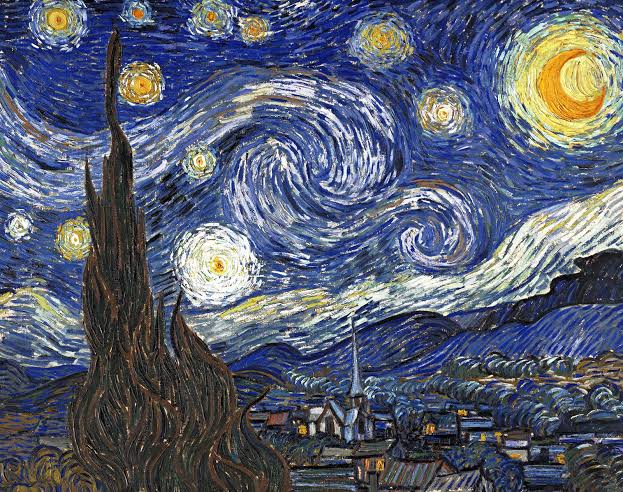Historically, art has always had a market. When one medieval fiefdom defeated another they would drag back its jewels, gold, tapestries and art objects as the spoils of war. Art equaled power, riches and culture
-Arne Glimcher

Hi there!
I am Luth N. Inocencio III, I am 19 years old. Currently, I am a first year BSMT student at John B. Lacson Foundation Maritime University-Arevalo.
I am ambitous, fun, loyal, and a fierce competitor.
My greatest goal in life is to know God more and more each day as I establish my faith in him, and to enjoy the things that I have and I want to have, and the people I am with.



Basketball

I'm a gamer too!

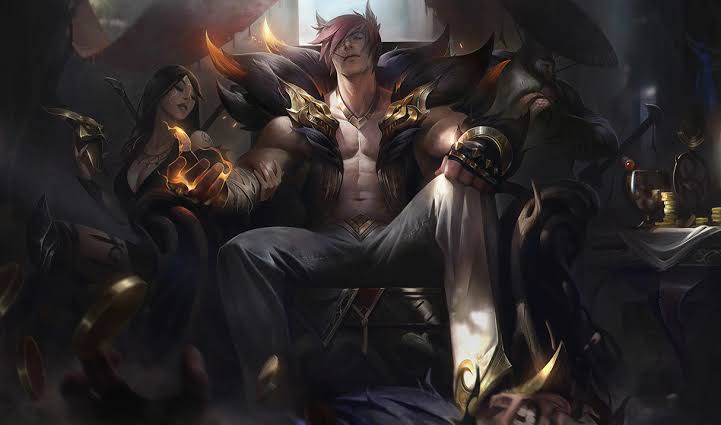
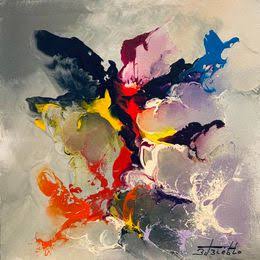
The principles of true art is not to portray, but to evoke

Art is a huge part of our culture which shapes our ideas and provides us with a deeper understanding of emotions, self-awareness, and love.

Art will always function as art until it is not considered as art anymore. Everything that has a purpose has a function. An artwork which has no function, has no purpose, is not considered art anymore.
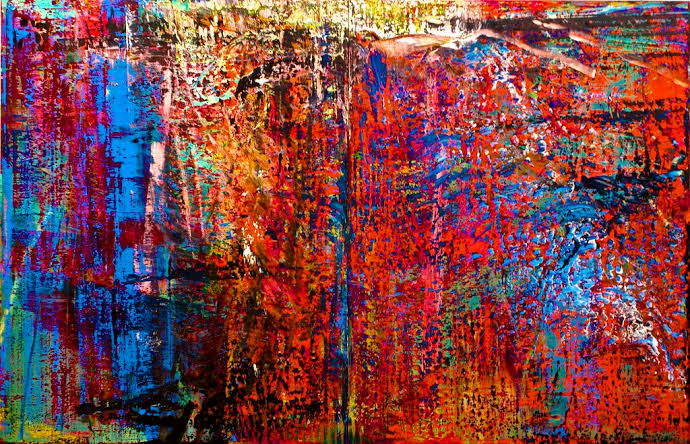
Medium and technique affects nothing to a work of art. I firmly believe that no medium nor style can determine the impact of an art work. An art work is measured not with its choice of colors or how clean it is, it measured by its impact to someone's life becuase the most beautiful thing about art is that, art is the artist's heart. It depends on us, audience, how to see it.

Crack in the Hull - Ronald Ventura
This painting is the modern interpretation of the Manunggul Jar, the painting symbolizes digging up the past and connecting it to the present. This painting depicts how souls go to the next life, aboard boats, pass through the rivers and seas.
Early Filipinos believed that a man is composed of a body, a life force called ginhawa, and a kaluluwa. This explains the painting itself and also showcase the design of the cover of the Manunggul Jar that features three faces: the soul, the boatman, and the boat itself.
Looking at the painting, the two human figures in a boat represent a voyage to the afterlife. The boatman is holding a steering paddle while the one on his front shows hands crossed on his chest. As how I understand the painting, the soul or the human figure which his hands are crossed, represents the dead, the boatman is like the Grim Reaper or the tour guide which guides the soul to his journey in the afterlife, and the boat itself serve as the judgement seat, wherein, if the result of the soul's judgement made him fail to successfully complete the journey, the soul will be pushed out of the boat, if otherwise, the soul will successly have a good life after death.
Ventura was inspired by the Manunggul Jar and the meaning of the jar, that's why he creatively recreated the cover of the jar through painting, with this, I can say that he wants to express or to show the early Filipinos belief on life and death through his painting.
To sum up everything, Ventura's main subject for his painting is the soul, the boatman, and the boat itself, the source or inspiration of his work is the Manunggul Jar, he expressed it through painting and the type of subject he established is portraiture.

An artwork is a product of an artist's creativity, imagination, past experiences, and sense of selflessness and openness. To create a piece, an artist make use of everything in his bag with the best tools and passion. Variations are used by artists to give their work a unique blend that is consists of a variety of elements. Using the lines, shapes and color elements together, their contrasts can give the artwork a better quality to attract the attention and give the audience a playful vibe. Overlapping is the technique used to overlap objects over one another to create illusions, 3-D effect, or depth in an artwork. It gives the audience a little bit of technicality in terms of arrangement and providing the audience a perspective in establishing size and distance in an artwork. The dominant elements are the strong focal points of art that gives the viewers an idea of the message of a particular art work. The dominance in art must be catchy and critical to the point that it is easy to understand by its viewers.

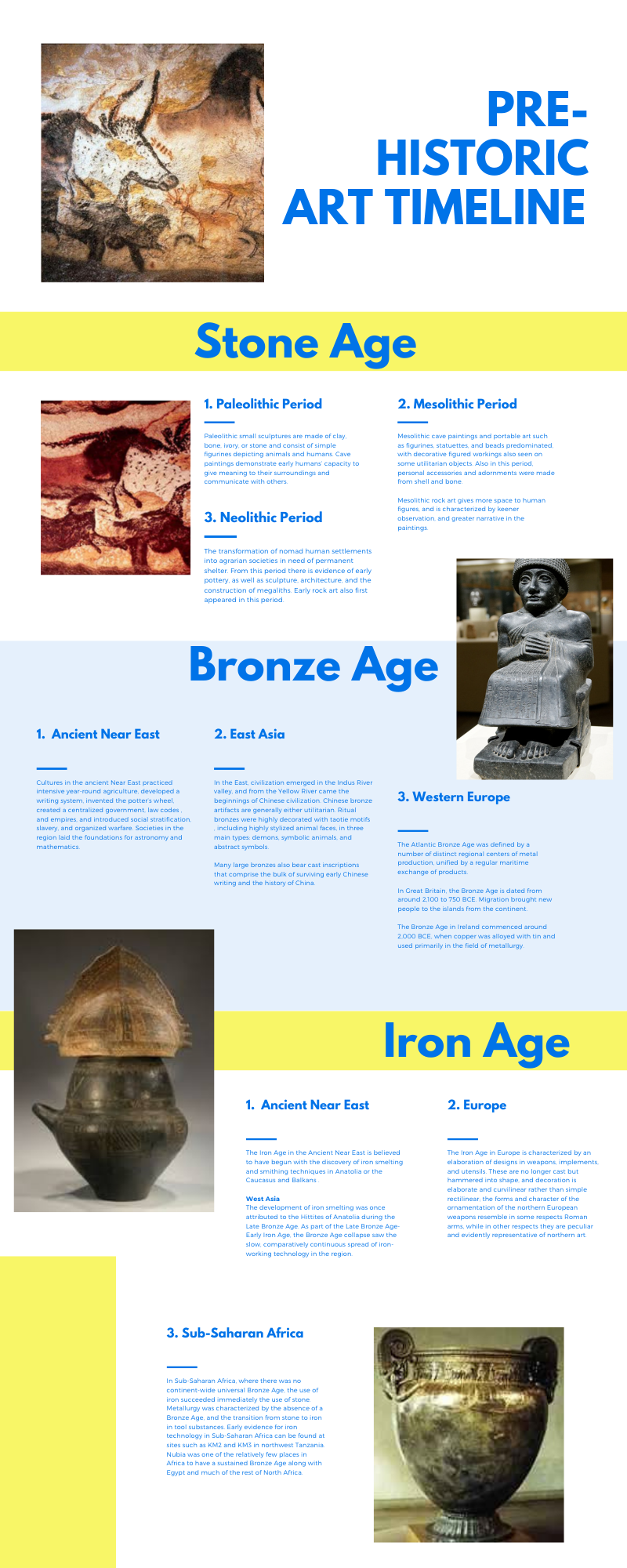
In ancient, prehistoric times, the temples of the spirit were outwardly visible, but today, when our life has become so unspiritual, they no longer exist where we can see them with our physical eyes. Yet spiritually they are still present everywhere, and whoever seeks can find them.
Rudolf Steiner

Lion Man is a carving made out of a mammoth tusk that dates back to an amazing 35,000 to 40,000 years old, making it an extremely ancient example of human art and likely a glimpse into the world of humanity’s first religions.
The statue is of a person with a lion’s head, much like the Egyptian Sphinx (albeit in reverse), only from many thousands of years prior. The sculpture stands 31.1 cm or 12.2 inches in height and was carved with a simple flint sculpting tool back in ancient prehistory.
In fact, it’s so old that its dating places it square in an ice age. Discovered in 1939 with a slew of other artifacts from the same people and period of history.
Lion Man stands out from the rest as a truly fascinating work of prehistoric human art from the Paleolithic period. It proves that humans did not need to harness a writing system before their imaginations could dream up supernatural things, possibly even gods.
Ivory carvings were prominent in the period, showing humankind’s tenacity to weather the crushing cold and still create art that fascinates and inspires us today.

The Lion Man is a masterpiece. Sculpted with great originality, virtuosity and technical skill from mammoth ivory, this sculpture that has the head of a cave lion with a partly human body is a symbol of ancient religious beliefs and worship.
The sculpture also shows the creativity of ancient people to create a piece of magnificent art carved using edged stones.
Material: Ivory
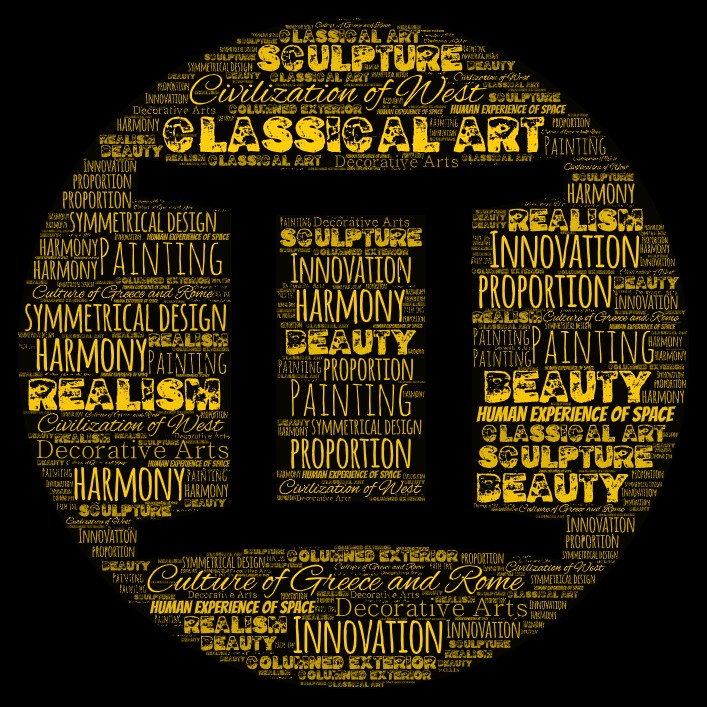
Classical Art encompasses the cultures of Greece and Rome and endures as the cornerstone of Western civilization. Including innovations in painting, sculpture, decorative arts, and architecture, Classical Art pursued ideals of beauty, harmony, and proportion, even as those ideals shifted and changed over the centuries.
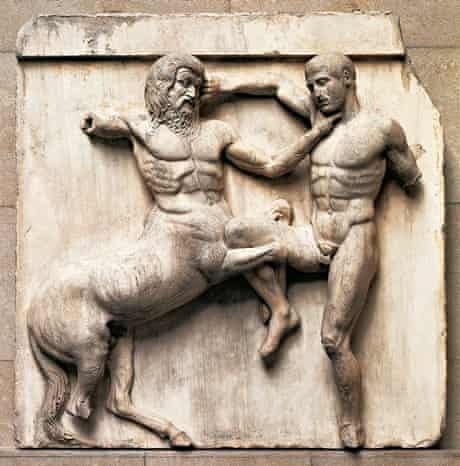
The metopes of the Parthenon are the surviving set of what were originally 92 square carved plaques of Pentelic marble originally located above the columns of the Parthenon peristyle on the Acropolis of Athens. If they were made by several artists, the master builder was certainly Phidias. They were carved between 447 or 446 BC. or at the latest 438 BC, with 442 BC as the probable date of completion. Most of them are very damaged. Typically, they represent two characters per metope either in action or repose.
The interpretations of these metopes are only conjectures, starting from mere silhouettes of figures, sometimes barely discernible, and comparing them to other contemporary representations (mainly vases). There is one theme per side of the building, representing a fight each time: Amazonomachy in the west, fall of Troy in the north, gigantomachy in the east and fight of Centaurs and Lapiths in the south. The metopes have a purely warlike theme, like the decoration of the chryselephantine statue of Athena Parthenos housed in the Parthenon. It seems to be an evocation of the opposition between order and chaos, between the human and the animal (sometimes animal tendencies in the human), between civilization and barbarism, even the West and the East. This general theme is considered to be a metaphor for the Median wars and thus the triumph of the city of Athens.
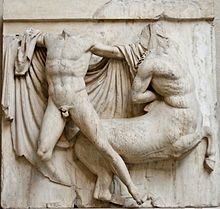
Violence is a favourite theme of ancient Greek artists. Anchored on the myth of the Trojan war and experiencing the reality of wars with Persia and between Greek cities, classical artists found new ways to show conflict. This human fighting a centaur, carved for the Parthenon in Athens, is astonishingly real in its detail and dynamic energy.
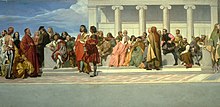
Phidias (480 – 430 BC) was a Greek sculptor, painter, and architect. His Statue of Zeus at Olympia was one of the Seven Wonders of the Ancient World. Phidias also designed the statues of the goddess Athena on the Athenian Acropolis, namely the Athena Parthenos inside the Parthenon, and the Athena Promachos, a colossal bronze which stood between it and the Propylaea, a monumental gateway that served as the entrance to the Acropolis in Athens. Phidias was the son of Charmides of Athens. The ancients believed that his masters were Hegias and Ageladas.
Phidias is often credited as the main instigator of the Classical Greek sculptural design. Today, most critics and historians consider him one of the greatest of all ancient Greek sculptors.

Historically, art has always had a market. When one medieval fiefdom defeated another they would drag back its jewels, gold, tapestries and art objects as the spoils of war. Art equaled power, riches and culture
-Arne Glimcher

Date Created: 1340s
The painting show details such as the piercing of Christ's side with a spear and his blood flowing out of his body like a running water on a faucet.
We can also see the breaking of the legs of the thieves.
The portraiture show the Virgin swooning into the arms of her companions depicting and showcasing deep sadness, pain, and heartbreak of losing a child.
Pietro Lorenzetti did a really good job of using a gold background to contrast every detail of curves, lines, and color he used in his portraiture. In contrast, the gold background highlighted the color palette he used on Christ's skin color and the two theives beside him, and several people present in the portrait, the cross, and the two horses.
The backgroud present a catch to attract its veiwer's eyes.
The artist also used colors contradicting the gold background like blue, red, gold, mint green, and light maroon on clothes of Virgin Mary and her companions.
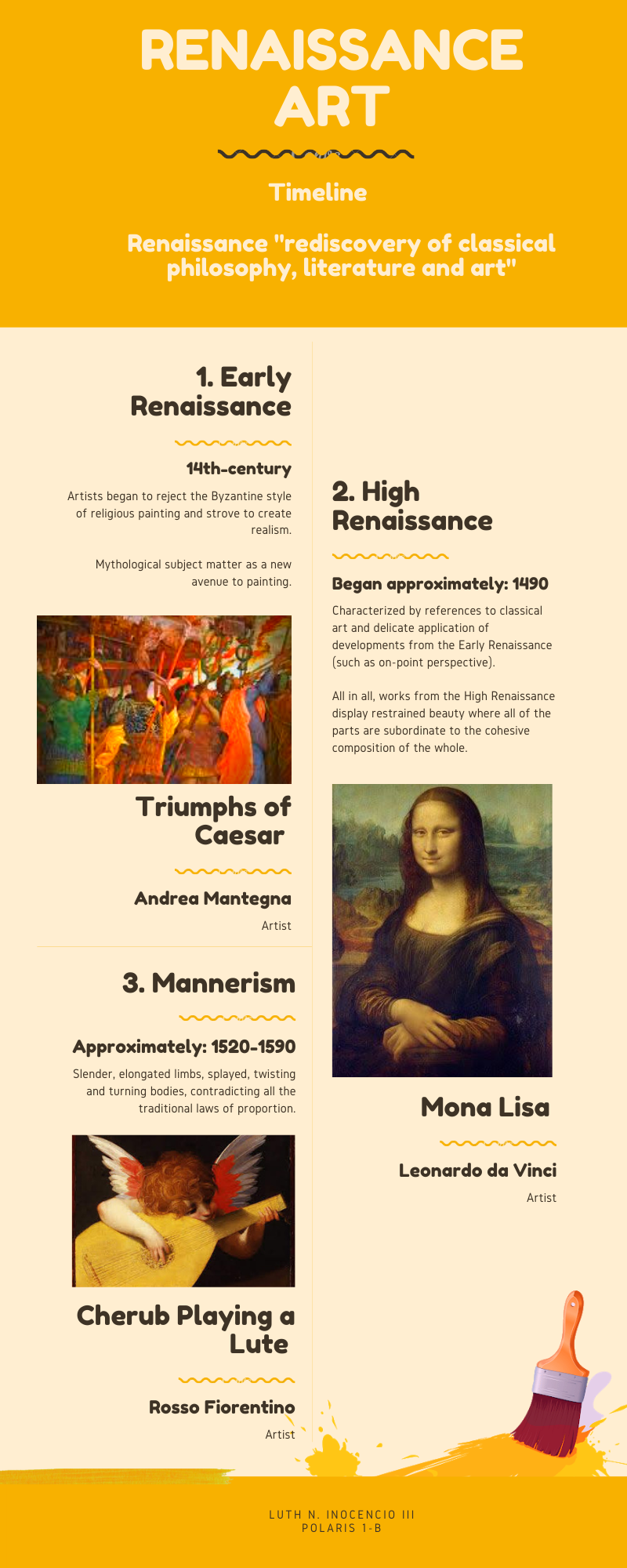
Renaissance art is marked by a gradual shift from the abstract forms of the medieval period to the representational forms of the 15th century. Subjects grew from mostly biblical scenes to include portraits, episodes from Classical religion, and events from contemporary life. Human figures are often rendered in dynamic poses, showing expression, using gesture, and interacting with one another. They are not flat but suggest mass, and they often occupy a realistic landscape, rather than stand against a gold background as some figures do in the art of the Middle Ages. Renaissance art from Northern Europe emphasized precise detail as a means of achieving a realistic work.
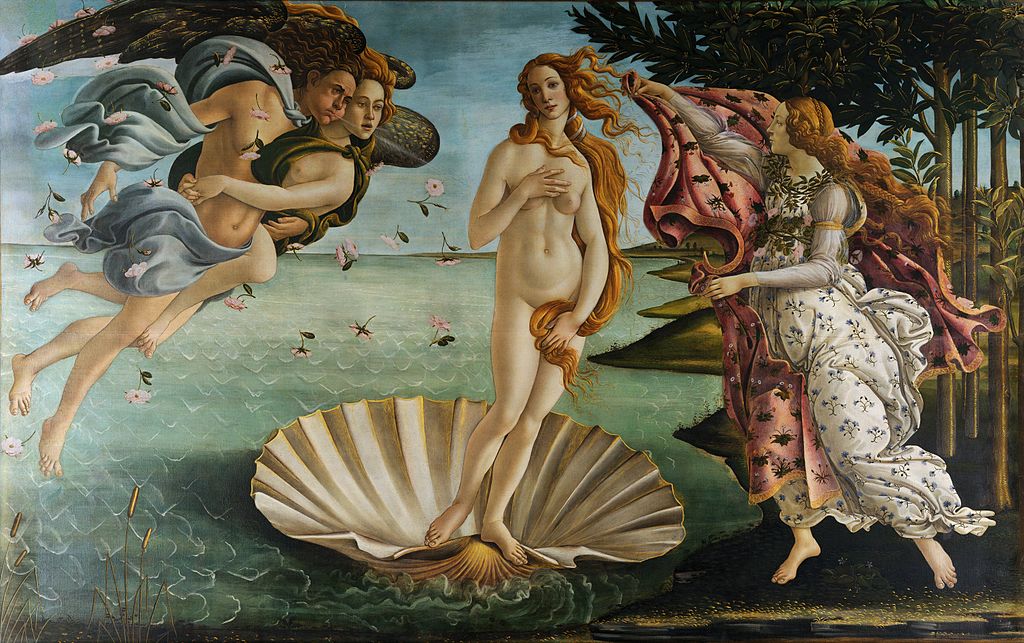
We can see on this painting that the woman is prominently depicted in the center, and she rides to shore.
On the left side, there are two figures of woman.
On this painting, we can see that the woman in the center is slightly to the right of center, and she is isolated against the background, Also, she has a slight tilt of the head, and she leans.
The hair and hairstyle of the woman reflected the way women wore their long hair in the late fifteenth century.
The significant part of this painting is the nudity of Venus.
In the painting, the dark lines were drawn around the contours of the woman's body to make it easier for the audience to see the woman's bodily forms against the background, and it also emphasized the color of her skin.
Warm colors were used on this painting.
Shades of green, blue, dark red, brown, white, pinkish white, dark green, ocean green, red, and pink were used.
Light brush strokes are used on the insides of all the figure's body and broad brush strokes with volume were used to make the highlights.
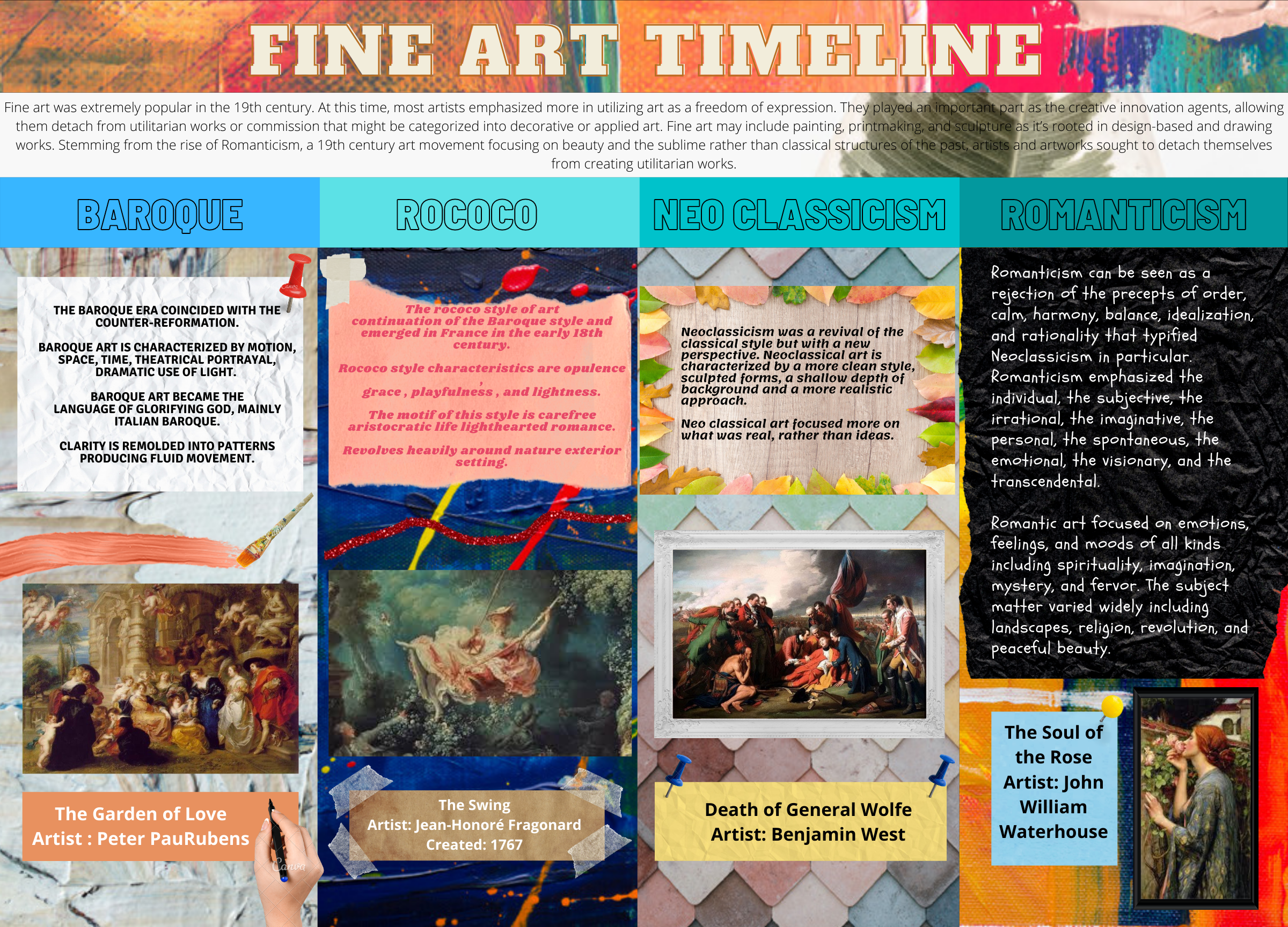
“Painting is poetry that is seen rather than felt, and poetry is painting that is felt rather than seen.” ~Leonardo da Vinci.
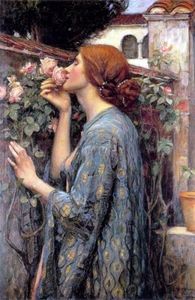
The main focus in this piece is the woman in the center of the painting.
The artist use high walls and horizontal and vertical lines that create a feeling that this woman is trapped both physically and metaphorically.
The artist draws the viewer to the women's face and her sense of longing as she smells the rose.
On this painting, the artist uses a warm palette of colors.
Mixes of pinks and earthy oranges and browns help to evoke a sense of summertime, which help to emphasize the blush of the women's cheeks that contrasted by the cool blue used in her elaborate dress.
Free brush strokes are used to convey detail and reality into this painting.
Romance is depicted on this artwork because the woman emphasized on this painting scent the rose, her eyes closed and her faced slightly turned away from the viewer to indicate that the woman has her own thoughts.
Natural lighting was used in this piece to create realism and makes the scene more believable.
The lighting also highlights the woman's skin and hair.
Art movement: Romanticism
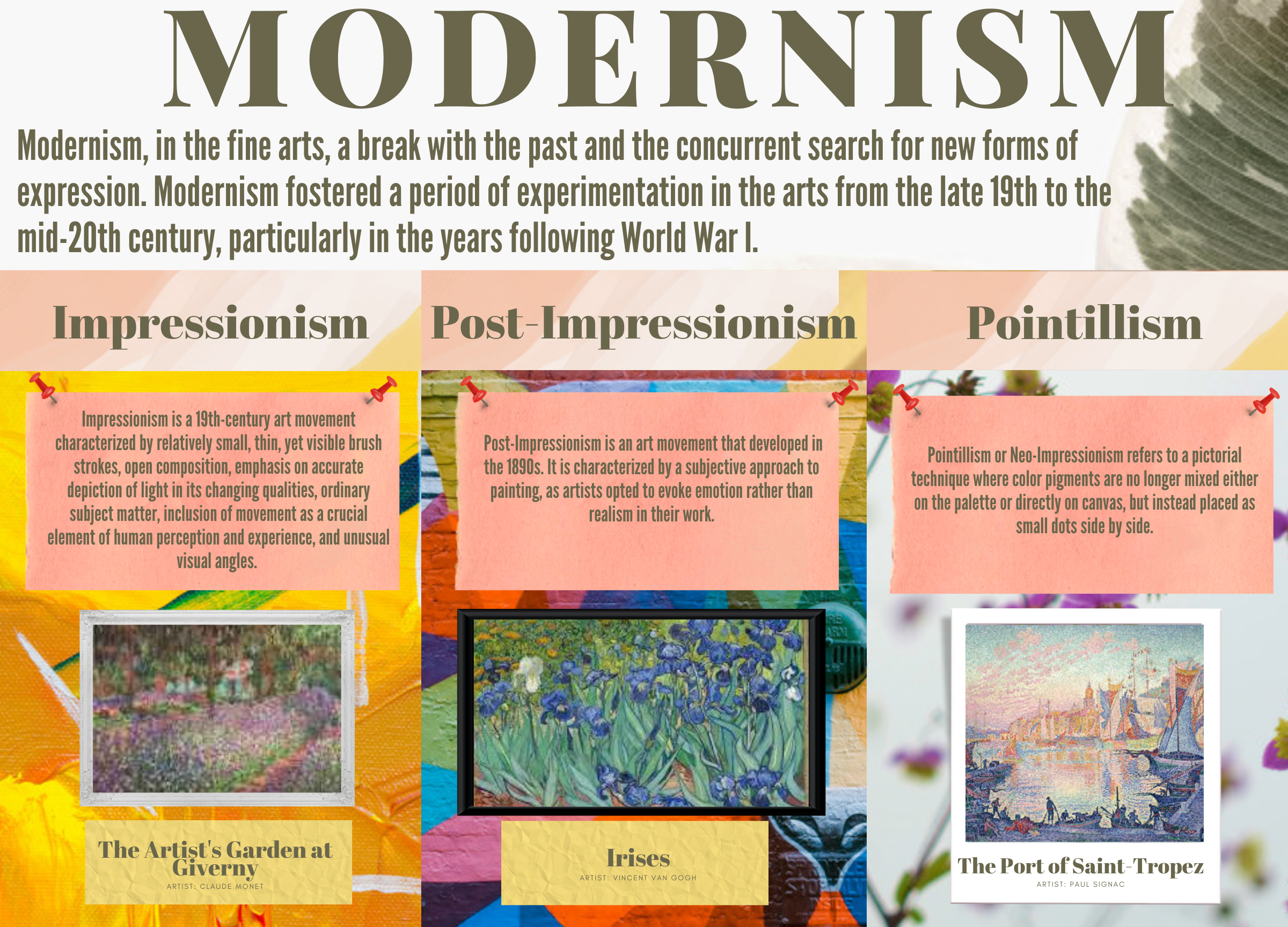
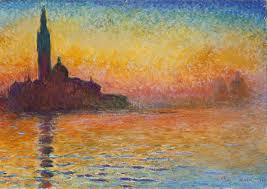
On this painting, Claude Monet used colors like white, yellow, blue, green, and red, and blended or mixed these colors directly on the canvas to show a setting sun on the water with light brush strokes.
Monet did a good job of separating the sunset from its reflection on the water by applying dark tones of black and red on the middle of the canvas beside the structure of a building depicted on the canvas, to create a partition.
He used colors of black, blue, green, red, and yellow, blended and directly applied on the canvas to create a structure.
Monet also used the same colors as of the sunset to the water, with the same light brush strokes but a little bit of curvy hand movement to depict a body of water reflecting a sunset.
Art Movement: Impressionism
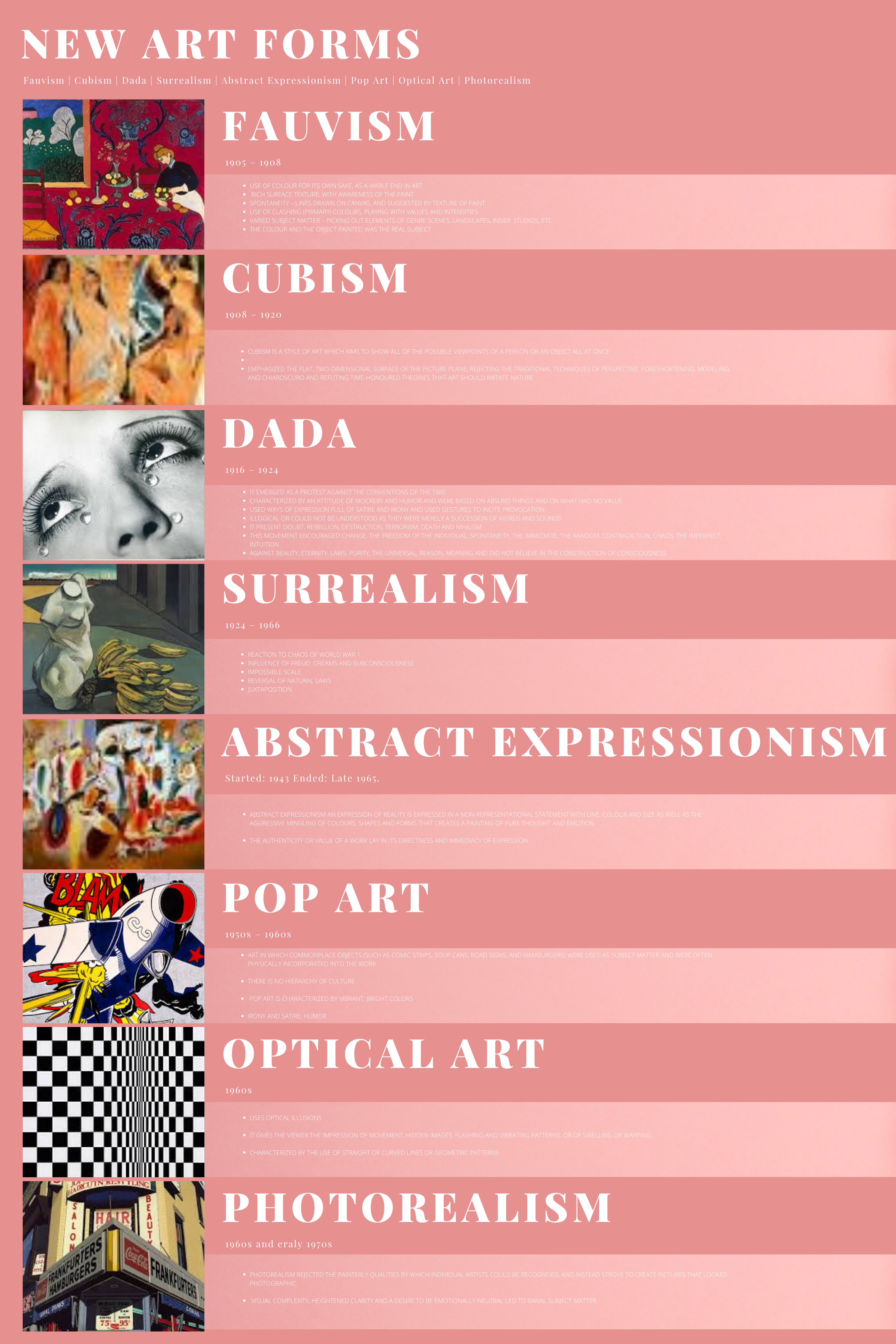
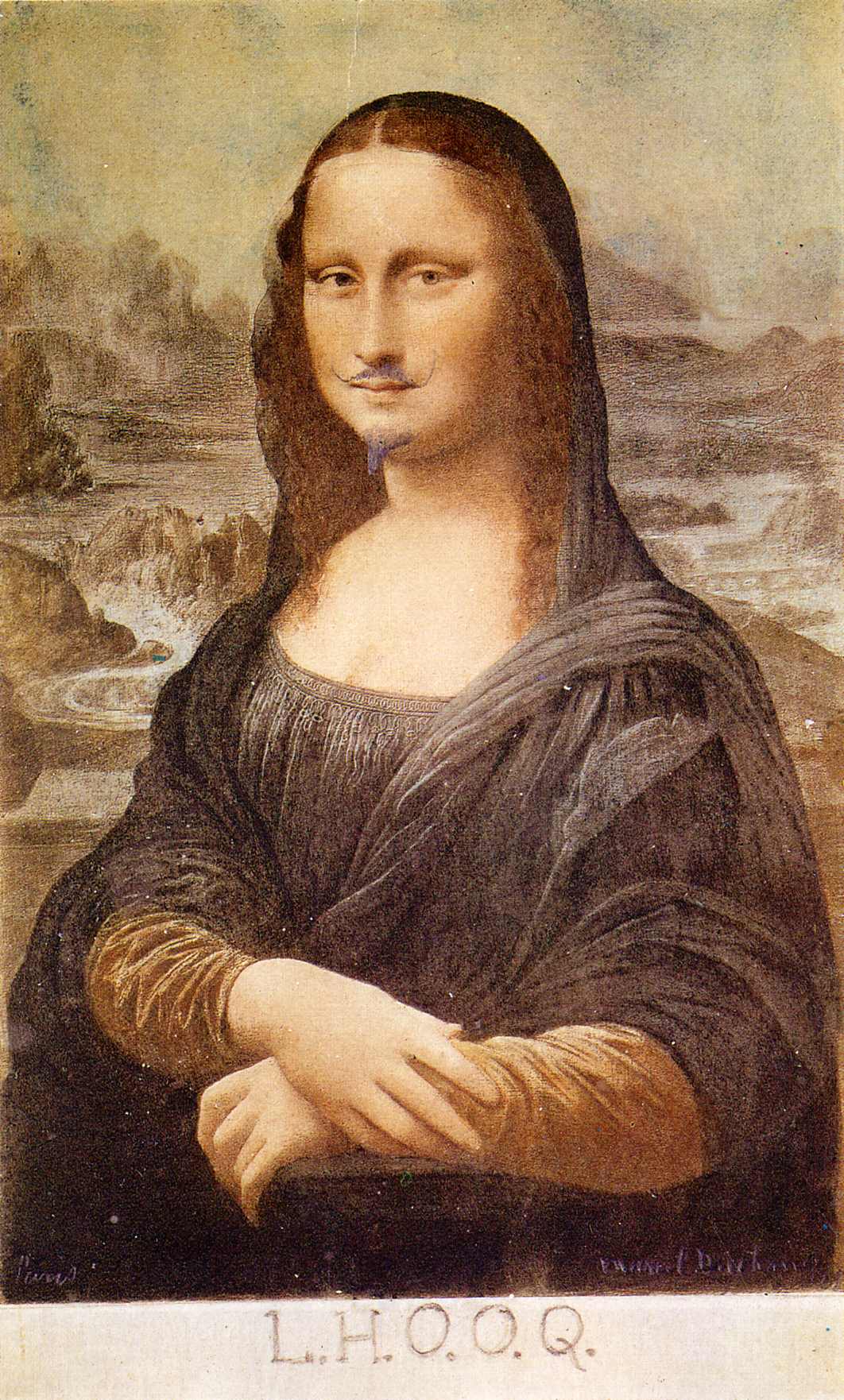
This portraiture is a modified-fun painting of Leonardo da Vinci's Mona Lisa. The artist drew a mustache and beard on her face and added the letters "L.H.O.O.Q." or "Elle a chaud au cul", or "She has a hot ass".
The painting itself and the "L.H.O.O.Q." text presented a vulgar expression of a woman, in sexual perspective in particular. The artist wants to convey that all women has a hot ass or hot but in a aesthetically fun way.
When I first saw this portraiture, I personally think that it is not funny, I felt like it's a little bit awkward and offensive, but its what Dada Art means, to rebel against beauty and tradition of art.
The portrait represented the ideal of feminine beauty, a rebellion against beauty in particular which is what art represents.
This art also represented gender reversal, or boy-being-girl and girl-being-boy which is very dramatic change of today, through this masculinized female portrait of Mona Lisa.
Duchamp just transformed a cheap postcard reproduction of Mona Lisa, reoriented it, drew a mustache and beard in pencil, wrote the title, and put the entire piece on a appropriate setting.
Period: Dada
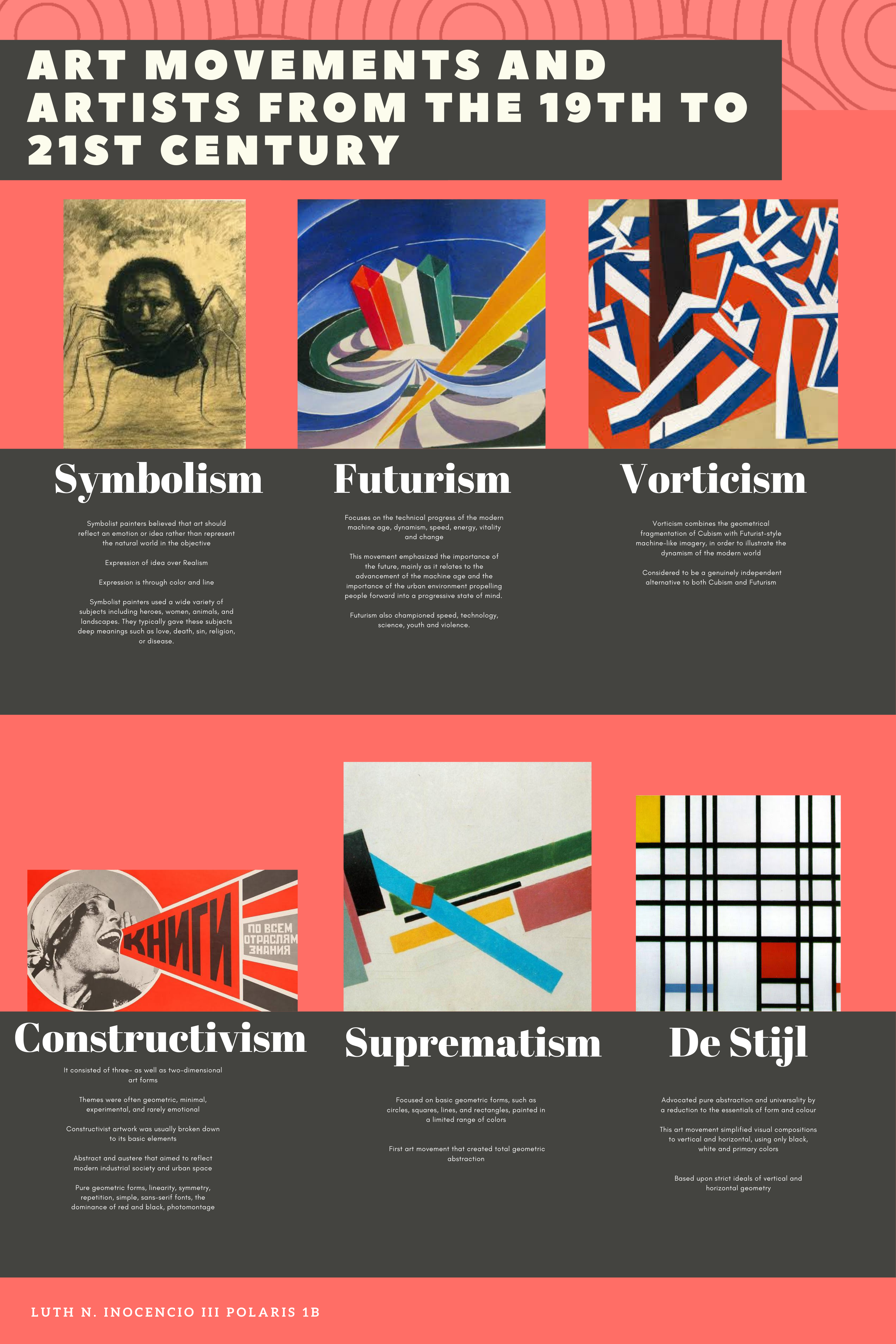
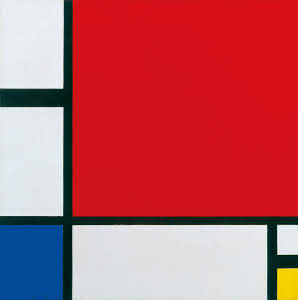
The artist uses White, Red, Black, Blue and Yellow colors to create his composition.
This piece is a product of relational opposites, asymmetry, and pure planes of color that created and arranged with rhythm and movement.
Personally, on my experience, my eyes was first directed to the red and the brought me to the whites, blue, and yellow through L-movement from the top to bottom-right. The movement made by the proper arrangement of colors really made this piece alive.
The black background highlighted all the other colors and also helped with the movement and balanced the colors.
De Stijl is not just about asymmetry or colors, its all about movements and arrangements that makes the entire piece signifies balance and force to influence real world, abstraction, and design.
Significant impacts of De Stijl is on the design approach which is, for me, the minimalism that is all about being minimal, balanced, and properly arranged. Also in architecture, designs in particular, we can see very minimal aesthetics in architecture today compared before.
Period: De Stijl
